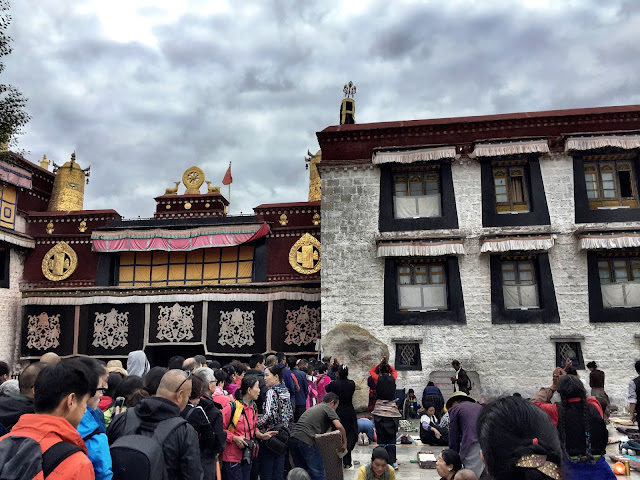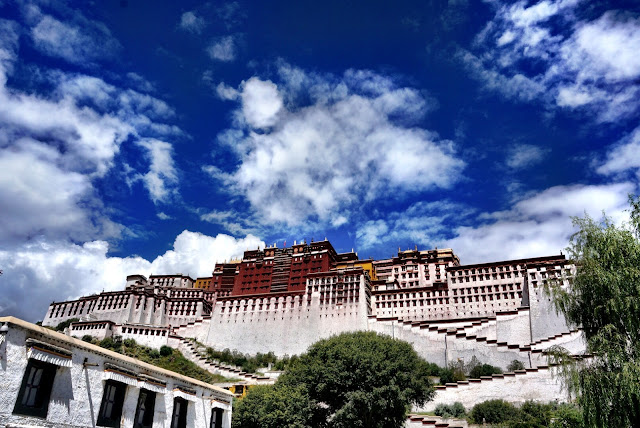The second city we would visit was Nyingchi 林芝, the third largest city in Tibet and located 400 kilometers to the east of Lhasa. Our original itinerary had planned for us to come back to Lhasa after Shigatze and to stay one more night in Lhasa before continuing our journey to Nyingchi. But that didn’t happen. Our trip so far has been smooth, on schedule, and uneventful. Little did we know that multiple dramas were awaiting us and we were caught off guard in the later part of our journey in Tibet.
We left Lhasa early in the morning since we had a full schedule of visiting many sightseeing spots. Our group of 39, sans the Taiwan passport holder who was denied the entry to Tibet, was split into two midsize buses. One hour into our journey, one passenger on one of the buses had a severe back pain and wasn’t able to sit. Luckily one of the passengers on that bus was a medical doctor. After the initial triage performed on the patient lying on the floor of the bus aisle, the patient was advised not to continue the trip and should go back to Lhasa and rest. It then took tremendous efforts by our tour agency Jason Tour, our tour guide Titian, our group leader Simon, and Dr. Wu working together to coordinate a transportation to carry the patient and his wife back to Lhasa. Our two buses, carrying the remaining 37 of us, then continued the journey toward Shigatze.
Later in the day, I had a chance to ask Simon about what transpired. He incidentally told me he had carried with him tens of thousands RMB in cash for this trip. I was stunned when he told me the reason. It turned out that hospitals in China demanded cash payments in advance of admitting patients. With our group comprising of mostly senior citizens, Simon felt the need to prepare cash, his own money, on hand in case any of us needed any medical care. In my usual naivete and blissful nature, it never occurred to me that Simon, being the group leader, had to put so many considerations and cares into making our trip possible. I was in awe and felt a tremendous debt to Simon. I hope some of my group members read this and realize how privileged we have been by having Simon leading our trip.
We were also informed that the highway between Lhasa and Nyingchi was closed for maintenance. Our original plan of returning to Lhasa and then continuing onto Nyingchi had to be changed. The new plan was that, after Shigatze, we would be going directly toward Nyingchi through a backroad bypassing Lhasa. The road condition might not be ideal, but it would get us to our destination. We were all new to Tibet and didn’t know the difference. We just resigned to the fact and hoped for the best.
DAY 9
Our first stop was Yangdork Lake 羊卓雍錯湖. The water and the sky were unbelievably clear and blue.
(Click on each picture to get the full-size view. Some pictures were taken by Ben, Peter, and others without explicit attribution.)

We drove along the beautiful and magnificent Yarlung Tsangpo River 雅魯藏布江. From two mountain passes, one at the elevation of 5000 meters, and the other at 4280 meters, views of the river were spectacular and the Tibetan Mastiff 藏獒 were majestic.
The Kharola Glacier 卡若拉冰川, at elevation 5560 meters.

Gyangz Castle江孜古堡

By nightfall, we reached Shigatze. We had dinner and checked into a hotel. The next day would be another day on the bus roaming through the heartland of Tibet.
DAY 10
After Shigatze, our first stop was Tashilhunpo Monastery紮什倫布寺. For the rest of the day after the visit to this monastery, I slept on the bus most of the time because of a minor cold. I have a very vague memory of what happened afterward.

Because of the road closure, we needed to be on a back road to get to Nyingchi. The road condition and the logistics along the way were less than desirable. For the bio-break, we sometimes had to relieve ourselves on the side of the roadway. After a few times, we got used to it with no problem. The bus ride today went through 320 kilometers, and we reached a small city called Zedang 澤當 by nightfall. We stayed in this city and would continue our journey toward Nyingchi the next day.
DAY 11
After leaving Lhasa, we had been on the road for two full days. The third day, from Zedang to Nyingchi, would be the last and the most torturous bus ride. On this day, we would be on the bus for 13 hours, traveling a distance of 460 kilometers. First, we traveled along the Nyang River 尼洋河. The marble quarry on the river bank reminded me of the Taroko 太魯閣 quarry in Taiwan.

At a scenery spot called Kissing Monkey Platform.

We didn’t see any kissing monkey so we improvised.
A small van taking venturesome tourists from the east coast of China to Tibet.

We stopped at a sand dune. Our Tibetan tour guide showed us how to slide down the dune.

But the majority of us preferred to find our own secluded corner and did our bio breaks.

By dinner time, we reached Nyingchi. We had dinner at a restaurant specialized in Stone Pot Chicken, a local delicacy.

Amidst our dinner, one member went out for a walk and lost his way back to the restaurant. We only found out that a person was missing after we finished our dinner and were preparing to board the bus. Several of us fanned out around the restaurant to look for the missing one. Our tour guide Titian and I went to a fire station nearby to ask for help. We were directed by the fireman on duty to go to a police station several street blocks away. After walking a block toward the police station, we heard a commotion behind us. It was the fireman we talked to earlier that was chasing after us. When he caught up with us, he showed us his palm with a number scribbled on it. The number was the fire captain’s phone number. The captain wanted us to call him for help if we couldn’t get help from the police.
At the police station, a policeman heard our plea for help and took us on his patrol car to search in the neighborhood. I was deeply impressed by the assistance offered by both the fire captain and the policeman. Contrary to what sometimes has been reported in the news about the brutality toward street vendors by the Chinese police, my experience for this night left me with a very positive impression about the public service personnel in Nyingchi. The missing person did find his way back after asking a local for help.
DAY 12
After staying one night in Nyingchi, we had a tour of several sightseeing spots around the city the next day. The first stop was the Seji Lashan mountain pass 色季拉山口, at elevation 4720 meters.

Our next stop was the Yarlung Zangbo Great Canyon 雅魯藏布大峽谷. With its depth of 6009 meters and its length of 509.9 kilometers, it is considered the deepest and widest canyon in the world. Our visit to this great canyon was at a forest called Lulang Forests 魯朗林海.

The last place we visited today was a village that was rebuilt into a resort. The layout, structures, and landscape were aesthetically designed and well planned. It was a very beautiful place, but we hardly saw any tourist there. Its tourist center housed the much appreciated clean toilets. The following pictures were from Ben, Peter, Danny, and others.

Lastly, me with Titian.
We stayed in Nyingchi for one more night before flying back to Chengdu the next morning. We had arrived at Lhasa on 9/14 and departed Nyingchi on 9/20, for a duration of 6 full days in Tibet.
The land of legends, religion, and mysteries – Tibet,
A once proud kingdom of the wise and the brave.
High mountain, deep water, and the vast expanse of landscapes,
Its most scarce commodities - clean toilets.














































































